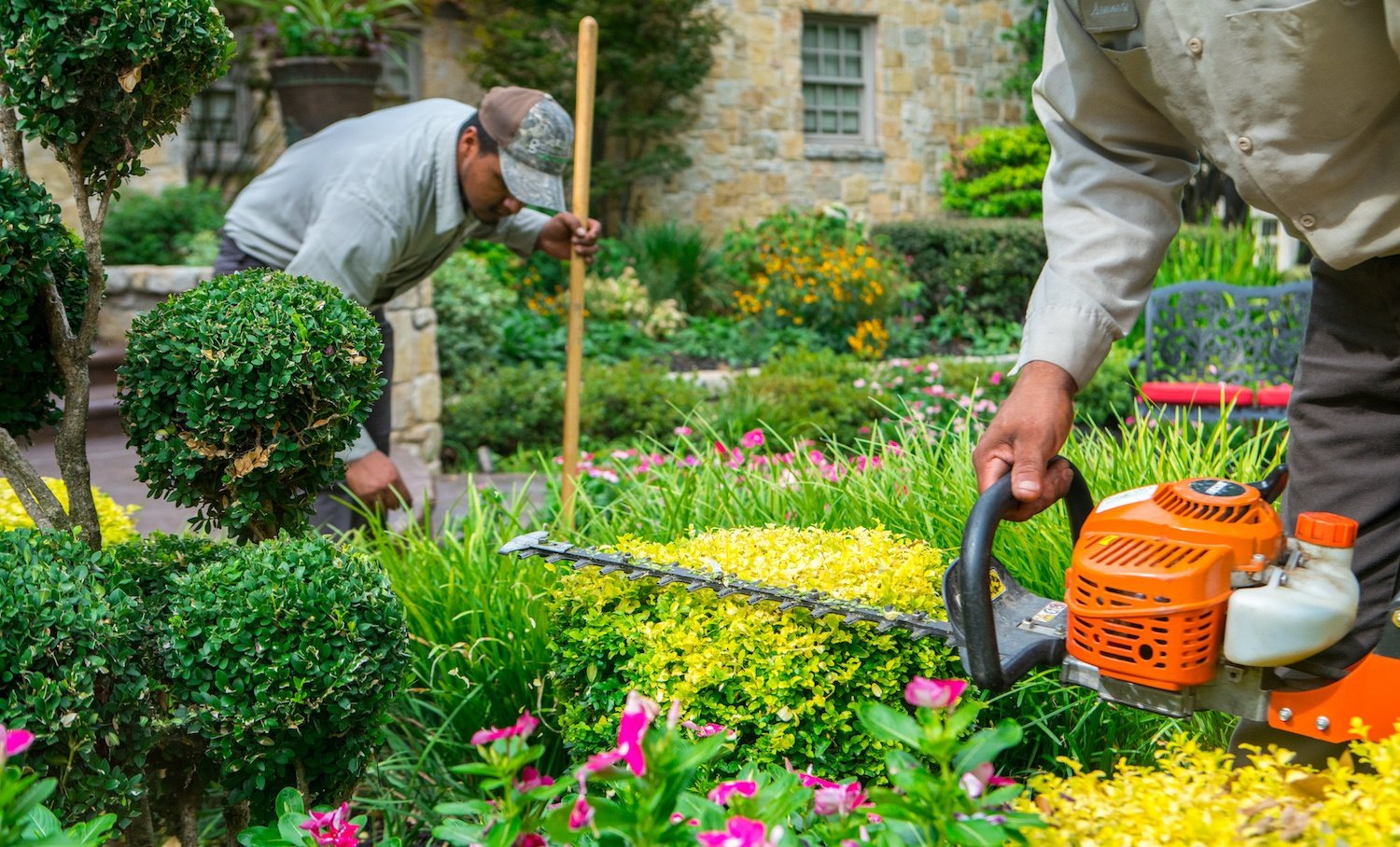
The first thing you see when you arrive home after a long day is your landscape. When you pull into the driveway, you want to feel proud—you’re ready to enjoy your outdoor space, and the last thing you want is to be tied down to a list of landscaping chores that will consume your free time. Even if you enjoy tinkering with a few minor tasks, there’s a lot more “dirty work” that goes into keeping a landscape healthy and attractive.
Maybe your landscape is fine now, but you know it could use improvements. You might have a landscape maintenance company that’s helping out with some tasks. Or, perhaps you’ve been taking care of the landscaping yourself and keeping up with everything feels impossible. (There is always something else to do: edging, clean-ups, trimming shrubs, mulching, you name it.) A full-service landscape maintenance solution—a pro who can handle all the things—would make your life so much easier.
If you’re reading this, you probably feel like there’s a better way to get the landscape you want without doing all the work. And, you’re right. Here, we’ll share how a full-service landscaping company manages all four seasons of maintenance.
As you learn what landscape maintenance tasks are essential for a north Texas lawn, also check out the lawn care services that make up a total maintenance plan. With this landscape maintenance guide, you’ll be prepared to hire a landscaping pro that can live up to your expectations, so you get the tidy property you deserve.
In this guide, we'll cover the following topics. Feel free to click on the links below and in each section, you'll find convenient links to come back here:
1. Seasonal Clean-Ups
2. Edging & Mulching
3. Landscaping Weed Control
4. Perennials & Ornamental Grasses
5. Ornamental Trees & Shrubs
6. Annuals, Bulbs, & Container Gardens
7. Plant Replacements
8. Irrigation
9. Lawn Care
10. Hiring a Landscape Maintenance Service
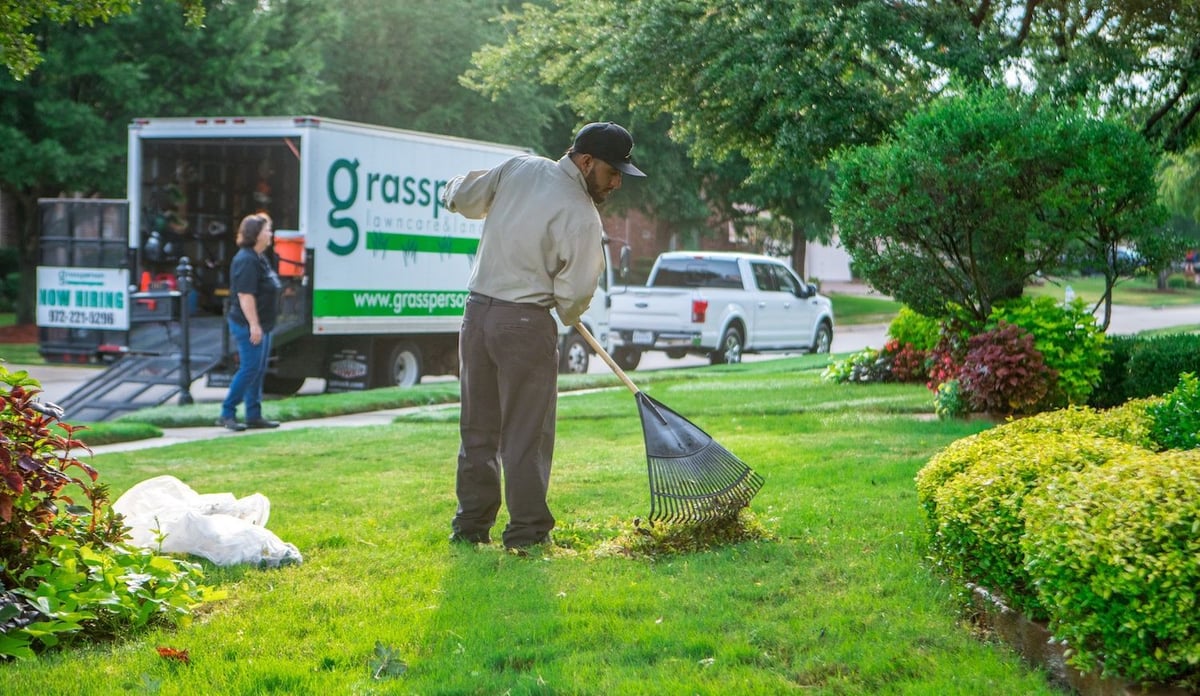 Weekly year-round services improve the quality, health and appearance of your landscape. But in spring and fall, your landscape needs more attention. In spring, cleanups include removing leaves and debris from landscaping beds. Leaves can drop year-round in Denton and Collin counties, TX. So even after a thorough fall clean-up, your beds will collect some leaves that should be removed before applying a fresh layer of mulch.
Weekly year-round services improve the quality, health and appearance of your landscape. But in spring and fall, your landscape needs more attention. In spring, cleanups include removing leaves and debris from landscaping beds. Leaves can drop year-round in Denton and Collin counties, TX. So even after a thorough fall clean-up, your beds will collect some leaves that should be removed before applying a fresh layer of mulch.
During spring cleanups, a professional will trim and prune trees and shrubs, as necessary. A fresh edge on landscaping beds makes a property look neat, clean, and ready for the season.
In fall, cleanups also involve removing leaves and debris from beds. Grasses and perennials should be cut back before winter. Shrubs may be trimmed—but harder pruning is saved for spring so tender, exposed cuts are not subject to freeze damage.
(Back to the Table of Contents)
The benefits of edging go beyond looks. Sure, edging creates a clean line between landscaping beds and your lawn. Because of that defined line, the edge keeps grass from encroaching on plant beds. For a manicured, neat appearance, you want to keep up with edging on a regular basis—that can mean weekly during spring and early summer when the landscape is growing quickly. Edging is performed after mowing during a landscape maintenance visit.
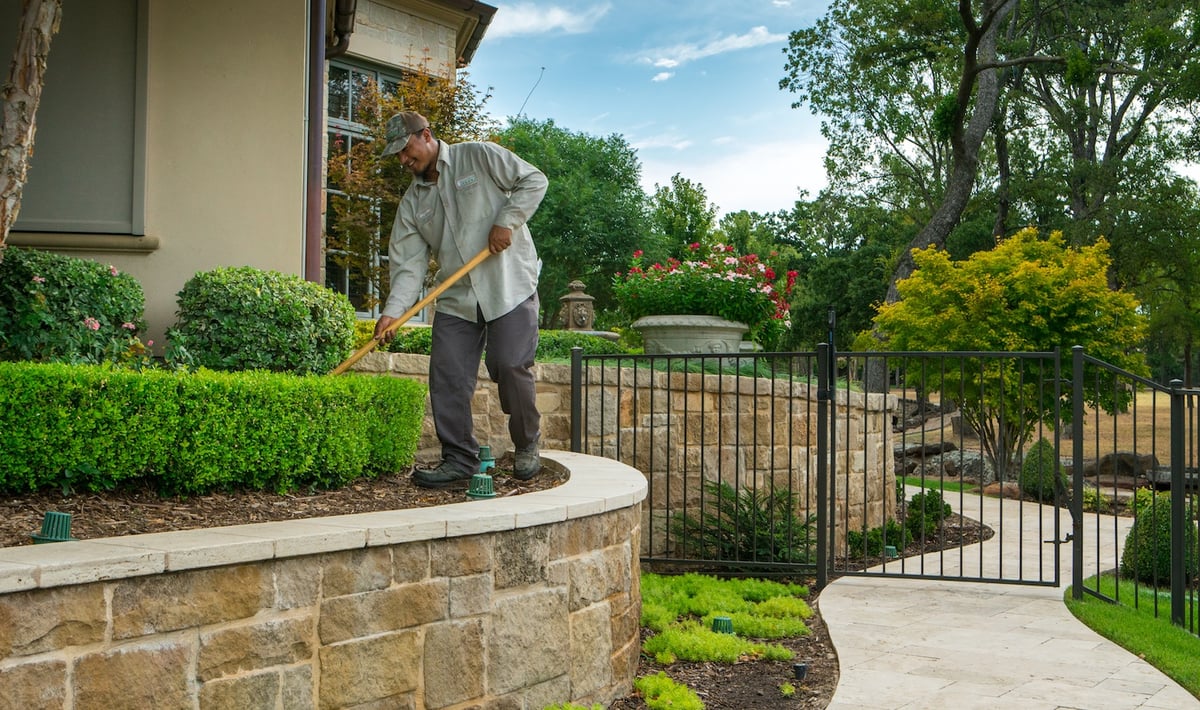 Mulch creates a rich backdrop for plantings and makes colorful annuals and perennials pop. Also, it’s an essential part of landscape maintenance because it enhances landscape beds by stabilizing soil temperature and protecting plant roots. Mulch helps retain moisture, which is helpful during hot North Texas summers when water restrictions are in place in many communities, limiting irrigation times. It also helps suppress weeds.
Mulch creates a rich backdrop for plantings and makes colorful annuals and perennials pop. Also, it’s an essential part of landscape maintenance because it enhances landscape beds by stabilizing soil temperature and protecting plant roots. Mulch helps retain moisture, which is helpful during hot North Texas summers when water restrictions are in place in many communities, limiting irrigation times. It also helps suppress weeds.
Mulch should be applied after spring and/or fall cleanup, after planting new material, and after the application of a pre-emergent herbicide. Existing mulch is churned up to improve the circulation of oxygen and nutrients, then a fresh mulch layer is evenly spread on top. Mulch should not exceed 2 to 3 inches in depth.
Proper mulch application involves taking care that mulch is not pushed up against tree trunks, creating a volcano effect. Mulch that is piled in domes around tree trunks can encourage insects and bacteria that damage the bark, putting plant health at risk. It should be spread around plants, but not forced up against stems.
In North Texas, preventing moisture from damaging homes’ foundations is a real concern. So, mulch should be applied so beds slope down away from the foundation to discourage water from collecting where it can lead to cracking and costly repairs.
(Back to the Table of Contents)
Mulch is an excellent weed suppressant, but alone it’s not enough to stop persistent weeds from encroaching on landscape beds. A multi-faceted weed control approach is necessary to get the best results. This often begins with hand-weeding landscaping beds to physically remove mature weeds. A landscaper will use tools to ensure the entire weed root is lifted out of the soil to prevent the plant from returning.
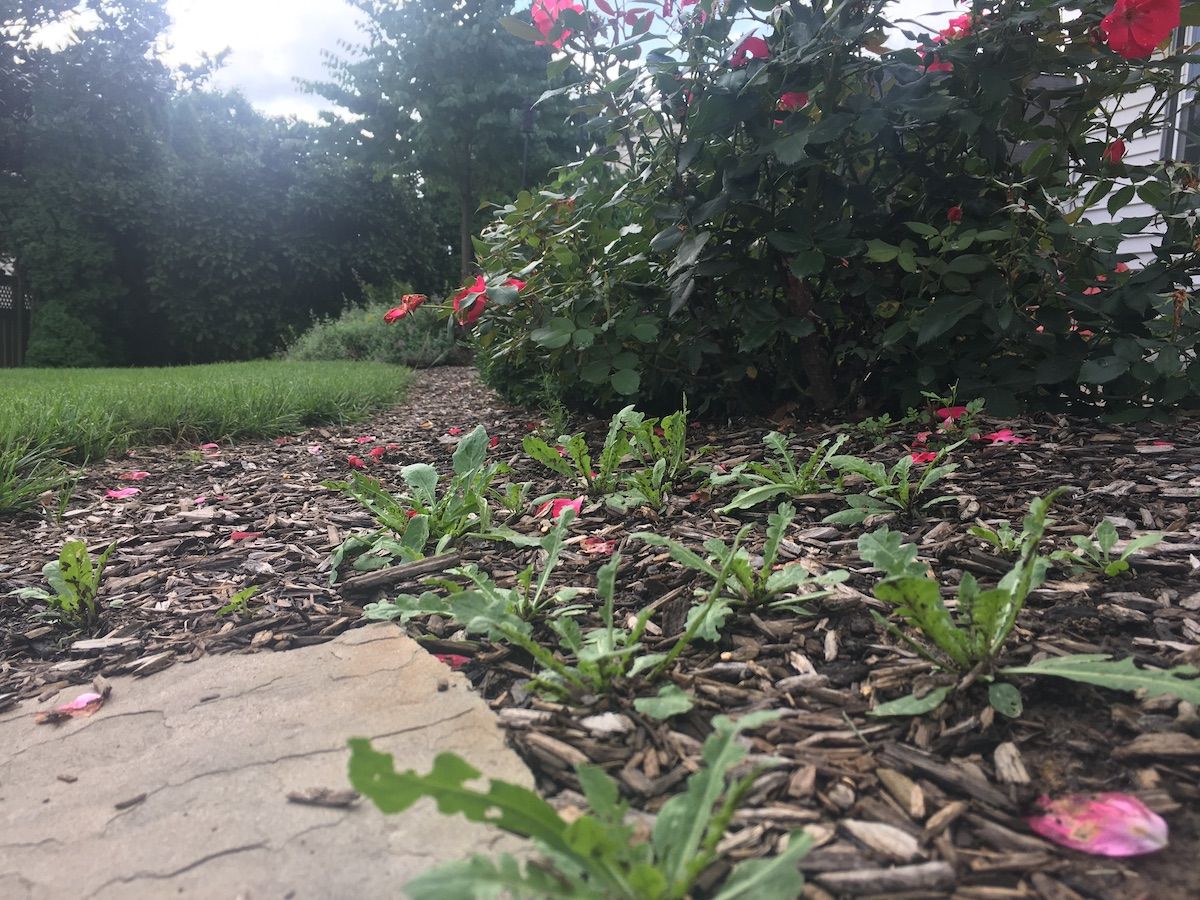 A pre-emergent herbicide should be applied in early winter and again in the spring to prevent germinating weeds from growing past the soil’s surface. Following this, a layer of mulch will discourage weeds by blocking air and sunlight. But again, these landscape maintenance steps will not guarantee weed control in landscape beds.
A pre-emergent herbicide should be applied in early winter and again in the spring to prevent germinating weeds from growing past the soil’s surface. Following this, a layer of mulch will discourage weeds by blocking air and sunlight. But again, these landscape maintenance steps will not guarantee weed control in landscape beds.
It calls for a holistic approach. Post-emergent contact herbicides can be spot-sprayed on problem areas of landscape beds to treat weeds that crop up. Use caution when applying herbicides near ornamental plants and only apply directly to known weeds. Additionally, hand-weeding throughout all four seasons will also keep weeds at bay.
Weed control can feel like a full-time job. It’s like a game of Whack-a-Mole: Just when you think you’ve got weeds knocked down in a landscape bed, they pop up in another part of your landscaping (or just feet away from the “treated” area).
Therefore, the best defense (and offense) against weeds is to layer the control with pre and post-emergent herbicides, mulch, and hand-weeding on a regular schedule throughout the year.
(Back to the Table of Contents)
Perennials are plants that grow for more than two years, and there are two types: woody plants like trees, shrubs, and vines; and herbaceous perennials, including non-woody plants that die back to the ground in fall. The roots survive and perennials grow back in spring.
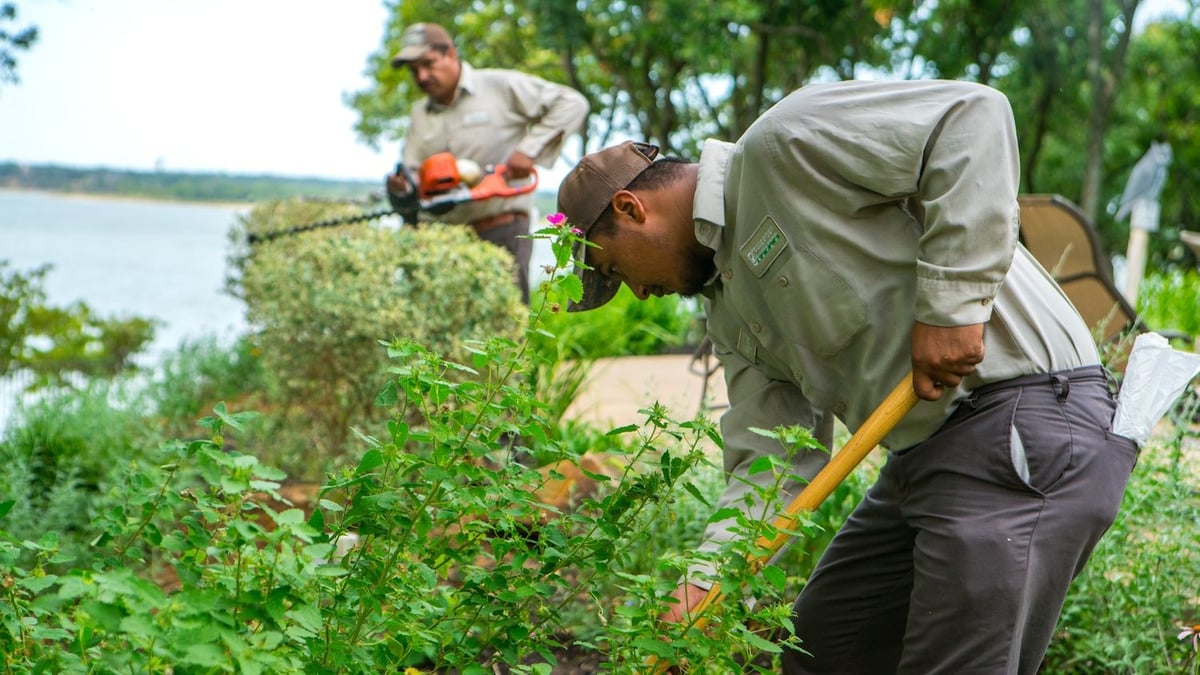 Many Texas property owners prefer perennials because they require minimal landscape maintenance and they provide consistency in landscaping beds. Not to mention, you can avoid purchasing plants every season, which is the case with annuals that bloom, pass, and must be removed. Perennials can be planted in spring, early summer and fall. Ideally, these plants are cut back after their final bloom so new growth can establish the following season.
Many Texas property owners prefer perennials because they require minimal landscape maintenance and they provide consistency in landscaping beds. Not to mention, you can avoid purchasing plants every season, which is the case with annuals that bloom, pass, and must be removed. Perennials can be planted in spring, early summer and fall. Ideally, these plants are cut back after their final bloom so new growth can establish the following season.
Ornamental grasses add texture and interest to landscape beds, and they tend to be hardy growers that require little maintenance. In fact, the only time you’ll need to think about cutting back grasses is before winter—or in early spring, if you choose to keep grasses through the cold season for visual interest.
Grasses can add color, which is the case with Purple Fountain Grass with its maroon blades and red seed heads. Gulf Coast Muhly offers fall color, and in spring grasses are a deep green.
A bonus of ornamental grasses: They sometimes attract butterflies and birds. (Preserving this habitat is a case some make for keeping grasses through most of winter and cutting them back before spring hatches.)
In general, perennials and grasses can be trimmed back during regular landscape maintenance visits if the plants are growing too large for their landscape beds. Ornamental grasses and perennials can be divided and transplanted in fall, which allows time for the plants to take root before winter.
(Back to the Table of Contents)
The shrubs and ornamental trees in your landscaping beds require year-round attention to stay healthy and look great year-round. That includes proper trimming and pruning, along with plant care to prevent insects, disease and to provide nutrition.
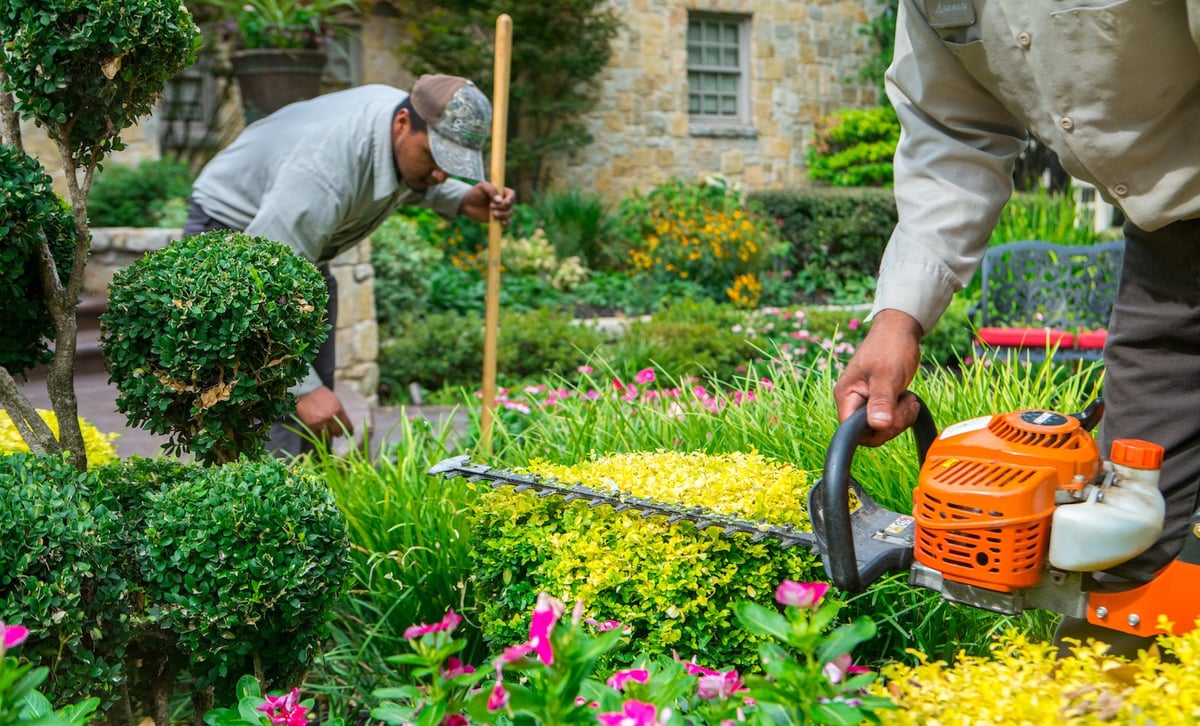 Trimming/shearing shrubs and ornamental trees in the landscape involves clipping off an inch or two of unruly growth for species like boxwood or aggressively trimming down a plant like Spirea to a fraction of its size. (You can remove about 90% of growth for this species and it will renew the next season.) So, trimming needs really depend on the plant, and a knowledgeable landscaping professional can identify plant varieties and determine what’s a healthy amount of trimming.
Trimming/shearing shrubs and ornamental trees in the landscape involves clipping off an inch or two of unruly growth for species like boxwood or aggressively trimming down a plant like Spirea to a fraction of its size. (You can remove about 90% of growth for this species and it will renew the next season.) So, trimming needs really depend on the plant, and a knowledgeable landscaping professional can identify plant varieties and determine what’s a healthy amount of trimming.
Pruning removes branches that are dead, dying, or diseased and makes room for new growth. Pruning can also be done to reduce the size or change the structure of the plant. Pruning is important because it helps improve plant health and increases plants’ longevity. Ideally, landscaping plants should be pruned in late fall or winter when they are not stressed from high temperatures and dry weather. This timing will prepare plants for new, healthy spring growth.
Your shrubs and trees also need protection from insects and disease. Aphids, grubs, spider mites, and beetles are some of the common landscape insects we battle in north Texas. Unfortunately, these pests can take down a perfectly healthy plant if you don’t take proper plant health care measures. This begins with cultural practices like properly watering plants, at least weekly and in the mornings. That way, moisture will not sit on leaves overnight and encourage bacteria or insects. Plant nutrition, including fertilizer, also helps encourage healthy growth.
Keep in mind, regular monitoring for pests is your best defense, and this takes a professional with pest ID knowledge. This way, if plants present with insects, proper control with a pesticide can be taken before damage occurs.
Larger trees on your property require special care from an expert with appropriate equipment and knowledge. A full-service landscaping company can connect you with a tree care professional for trees of significant size.
(Back to the Table of Contents)
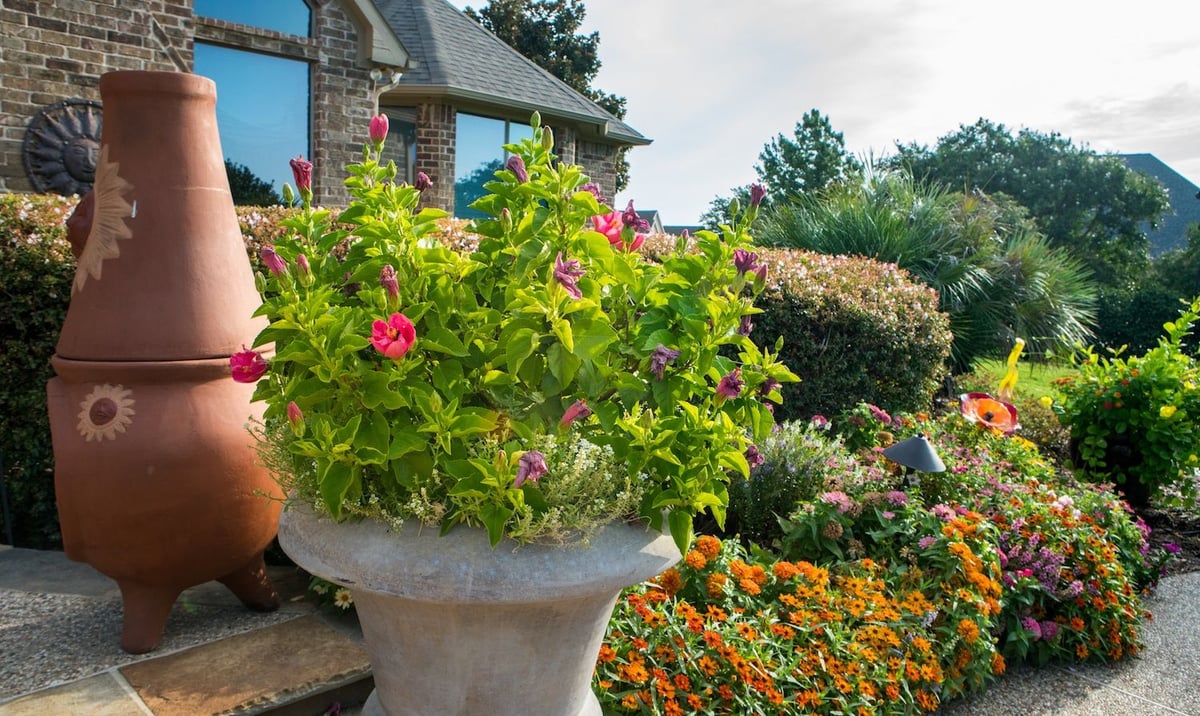 Introduce seasonal color to your North Texas landscape with annuals. There are a couple of waves of planting times that are ideal for this region. Spring is when to plant annuals like Marigold, Zinnia, and Celosia that will bloom through summer. Late-summer to early fall is the ideal planting time for autumn annuals including Dianthus, ornamental cabbage and kale, pansies and petunias. (A bonus—these fall annuals generally last through winter in Denton and Collin counties, TX.) Annuals make for a dynamic, vibrant, ever-changing landscape. But because of their growth patterns, they require ongoing planting, removal and related soil preparation and fertilization.
Introduce seasonal color to your North Texas landscape with annuals. There are a couple of waves of planting times that are ideal for this region. Spring is when to plant annuals like Marigold, Zinnia, and Celosia that will bloom through summer. Late-summer to early fall is the ideal planting time for autumn annuals including Dianthus, ornamental cabbage and kale, pansies and petunias. (A bonus—these fall annuals generally last through winter in Denton and Collin counties, TX.) Annuals make for a dynamic, vibrant, ever-changing landscape. But because of their growth patterns, they require ongoing planting, removal and related soil preparation and fertilization.
These should be tucked into well-drained soil in the landscaping between late September and early November. They need sun to part-shade, and they will be the first bloomers come spring.
Versatile containers can be changed out seasonally with annuals, or maintained over a longer-term if they contain evergreens, grasses or perennials. Container size also dictates care requirements. Larger containers suited for ornamental trees or plant groupings will actually demand less care, while soil in smaller containers dries out faster and plants are more likely to outgrow their “real estate” and require replanting. Container plantings need the same care as plants in landscaping beds: trimming, fertilization, and a watchful eye to identify potential insects and diseases.
(Back to the Table of Contents)
Plants grow at different paces, and this can result in one plant (or several) creating an overbearing presence in a landscape bed. In instances where plants were installed too close together, a bed quickly can become overgrown. You might have a species that is requiring an excessive amount of maintenance.
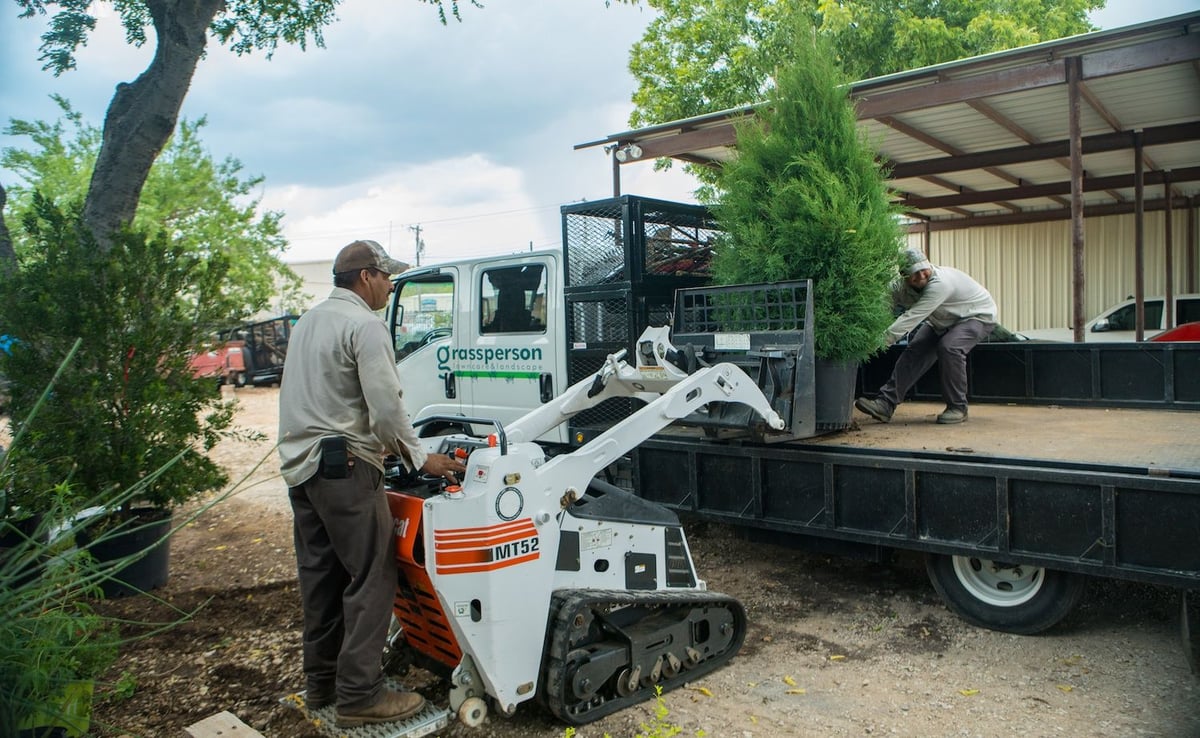 Or, perhaps you moved into a home where poor plant choices were made and the landscape beds are ready for an overhaul. These scenarios happen all the time in the landscape and can require an expert eye to assess plants’ condition, potential and value.
Or, perhaps you moved into a home where poor plant choices were made and the landscape beds are ready for an overhaul. These scenarios happen all the time in the landscape and can require an expert eye to assess plants’ condition, potential and value.
When evaluating a landscape bed, landscapers will consider the growth habits of plants, and their current size and health. Is there a sentimental value attached to a plant that makes it a “keeper?” Could the plant be transplanted to a different area of the landscape and perform better? (This is why a full-service landscaper’s big-picture perspective of your entire property is important.) How old are the plants? And, what is the estimated cost of maintaining them vs. installing replacements that might use less water and demand less trimming, fertilization, and overall care?
Really, this evaluation is an ongoing process, occurring through the seasons as your landscaping is maintained.
(Back to the Table of Contents)
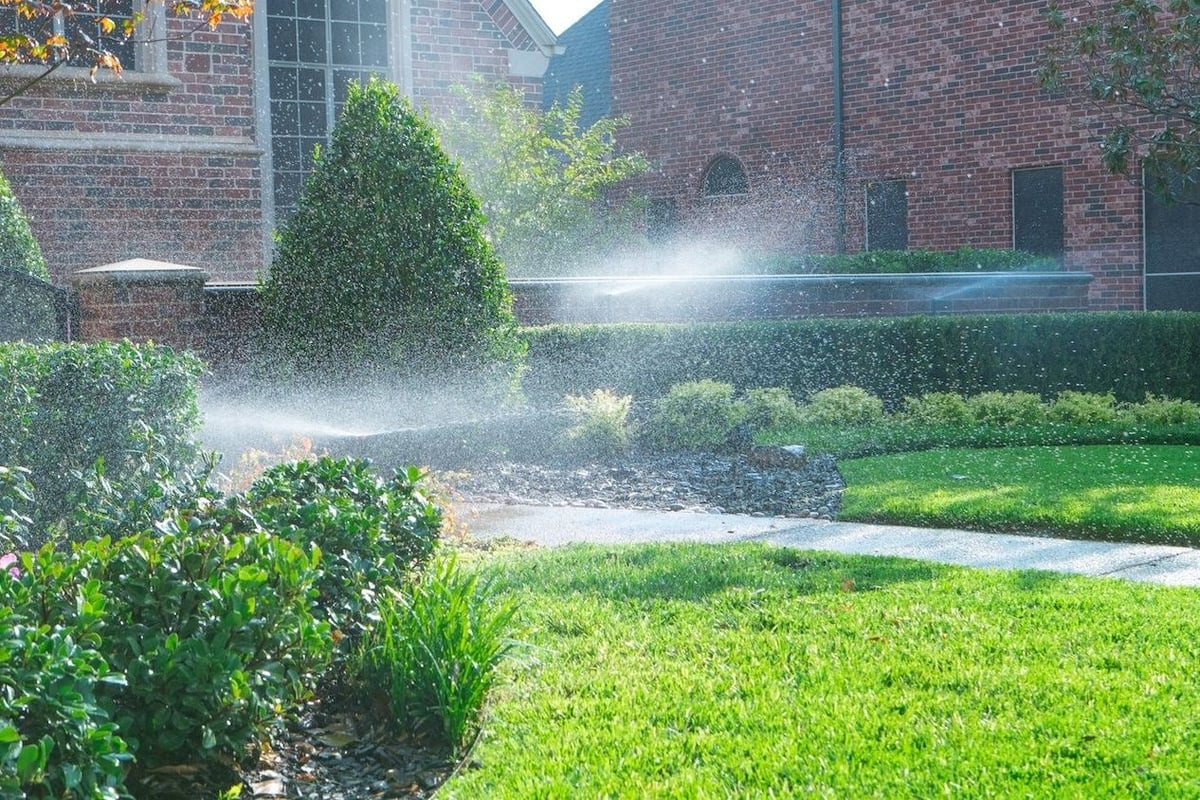 Your irrigation system in north Texas will stay on year-round because the landscaping needs watering during all four seasons. Drip irrigation systems provide the deep watering plants need to thrive by slowly “trickling” moisture into the soil. This way, water does not run off and out of landscape beds and, instead, absorbs into the mulch and soil to plant roots. Hand-watering plants can have the same effect. Again, the key is to deliver water to the plant roots.
Your irrigation system in north Texas will stay on year-round because the landscaping needs watering during all four seasons. Drip irrigation systems provide the deep watering plants need to thrive by slowly “trickling” moisture into the soil. This way, water does not run off and out of landscape beds and, instead, absorbs into the mulch and soil to plant roots. Hand-watering plants can have the same effect. Again, the key is to deliver water to the plant roots.
New plants and trees will require watering daily until the roots are properly established. Plan on several weeks of daily watering, then taper this schedule as the plant or tree develops. During hot Texas summers, your landscaping plants will require more attention. Plan on watering several days per week. The same schedule applies to your lawn.
Because your irrigation system runs year-round, it should be serviced annually and will require in-season maintenance checks to be sure all valves, heads, and the controller are working effectively. This work is best performed by a specialist, who can detect possible leaks and identify watering zones that might require adjusting. Not all landscapers are qualified to perform irrigation services.
(Back to the Table of Contents)
Your total landscape includes caring for the lawn: mowing, fertilization, weed control, and improving its density and health with aeration and sodding or seeding. We outline the proper year-round maintenance a North Texas lawn requires in this lawn care guide. Here are some basics:
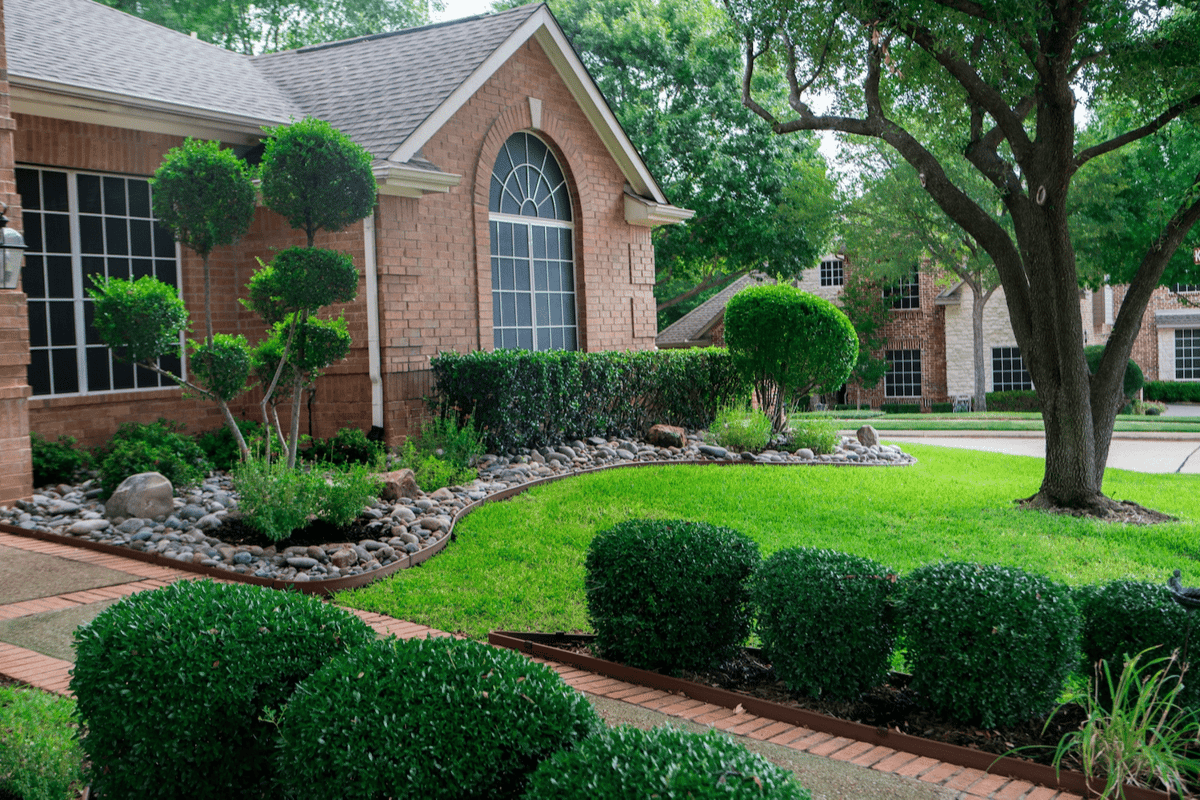 In Texas, the grass in our landscapes is one of these three turf types: Zoysia grass, Bermuda grass and St. Augustine grass. Zoysia can be mowed at 1½ to 3 inches. Bermuda grass should be mowed to 2 inches in height. And, St. Augustine grass can be mowed to 2½ to 4 inches.
In Texas, the grass in our landscapes is one of these three turf types: Zoysia grass, Bermuda grass and St. Augustine grass. Zoysia can be mowed at 1½ to 3 inches. Bermuda grass should be mowed to 2 inches in height. And, St. Augustine grass can be mowed to 2½ to 4 inches.
As part of a full landscape maintenance service, we recommend a year-round lawn care program that includes fertilization, pre-emergent and post-emergent weed control. Consistent, year-round fertilization prevents regression in the lawn. Pre-emergent applications help prevent weeds, particularly crabgrass from emerging. Curative treatments are also critical, and we call this post-emergent weed control. The take-away: Pre-emergent and post-emergent applications work together, so both are part of a complete program.
Aeration pulls up soil plugs, which breaks up thatch and loosens up compacted soil so grass roots have space to grow. Aeration also helps your lawn benefit from fertilizer applications because treatments can actually reach the turf roots once the lawn is “unplugged.” Overseeding involves applying new, resilient grass seed to your existing lawn. Together, aeration and overseeding is an important annual activities to revitalize your lawn.
(Back to the Table of Contents)
The ongoing maintenance that a healthy, beautiful lawn requires can become a full-time job. Landscape maintenance is a year-round necessity in north Texas, and getting the best lawn on the block takes more than pulling some weeds. From edging to mulching, and pruning to planting, there’s a lot to manage. Because of the growing nature of our landscapes, your Lewisville, Highland Village, or Flower Mound, TX property is always changing. Enlisting an expert to help maintain your landscaping lifts the burden of time, resources, and energy. Plus, you won’t have to worry about making costly mistakes if you hire a knowledgeable, professional landscaping company.
You deserve the best lawn and landscape on the block—and you’re making a choice to enlist in a professional so you can get the results you want. Find out how our Total Maintenance lawn and landscape maintenance services can make your life easier and give you the landscape you always wanted. Get a free quote today.
These Stories on Landscape